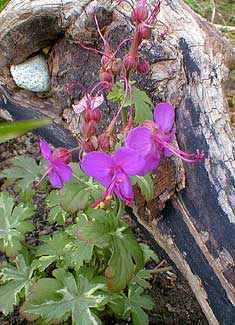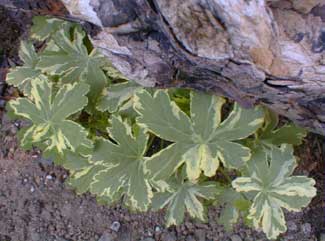
Variegated Bigroot Geranium
"I often ask myself what will become of Rydal Mount after our day. Will the old walls & steps remain in front of the house & about the grounds, or will they be swept away with all the beautiful mosses & ferns & wild geraniums & other flowers which their rude construction suffered & encouraged to grow among them?"
-William Wordsworth,
March 1840
March 1840
Several traits make Geranium macrorrhizum a standout among so many possible choices of hardy crane's-bill geraniums. It is called "Bigroot Geranium" because it has large thick rhizomes that poke right out of the ground & slowly spread across the surface, lending a tougher basal structure than is usually expected of crane's-bills.
Second & more thrilling are the magenta flowers with enormous rose-red calyces that give the blossoms an apparance that hardly resemble other crane's-bills at all.
Its third marvelous trait is how when the flowers turn into bird-bills, the seeds are decoratively red.
And fourth, for 'Variegatum,' the faintly musky leaves are more than normally beautiful, a bright light-green to mid-green with cream-colored stripes. Even when it is not in bloom, it is simply stunning.
 This southeastern European species rarely exceeds a foot in height but can spread out to a considerable width, slowly forming a colorful dense groundcover.
This southeastern European species rarely exceeds a foot in height but can spread out to a considerable width, slowly forming a colorful dense groundcover.Because of the thick large root, it is even hardier than the usual hardy geraniums. When established, it is fairly drought-hardy. It does well in poorer soils, & can do well as a container plant.
Ideally it is provided with moist well-draining soil, & a healthy portion of sunlight, but is so adaptable that if something is needed for a dryer shadier spot, the Bigroot will serve the purpose. 'Variegatum' is said to be a little more sensitive than other varieties of Bigroot Crane's-bills to dryness, but in our zone it is impossible to see it as anything less than ultra-hardy.
On Puget Sound it begins blooming as early as March, but certainly by April, & still in fully flower in July, with less extreme rebloom sporadically into Autumn. It is semi-evergreen in our zone but it is best to clip away whatever is left of last year's leaves before it starts its new spring season.
Every few years it can be divided for propagation purposes, but doesn't require division. Just slicing off an edge-rhizome can provide the start of a new plant without much unsettling the main clump.